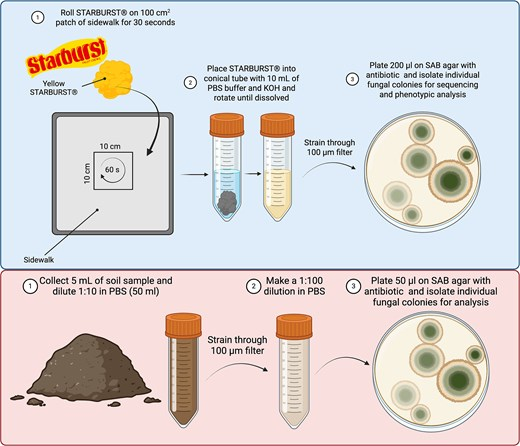Urban Fungi Are Developing Heat Resistance That Could Change How We Think About Pathogens

A new study by researchers at the Johns Hopkins Bloomberg School of Public Health has revealed that common urban fungi are showing signs of adapting to heat — a shift that could have long-term implications for both the environment and human health. Conducted in Baltimore City, this research offers a detailed look at how microscopic organisms living on our sidewalks and soil may be evolving to tolerate higher temperatures, thanks to the urban heat island effect.
The study, led by Daniel Smith and Arturo Casadevall, focused on understanding whether fungi from warmer neighborhoods within a single city were different from those in cooler ones. The results were published in ISME Communications on October 4, 2025, and they suggest that the answer is yes — some fungi are indeed adapting to heat, in measurable ways.
How the Study Was Conducted
The team selected four locations in Baltimore, each representing a distinct temperature profile — one cool, one average, one above-average, and one warmest site. To identify these, researchers used high-resolution temperature data from the National Oceanic and Atmospheric Administration (NOAA) and then confirmed those readings by measuring sidewalk and dirt temperatures at the exact collection spots.
What’s particularly fascinating is how the samples were collected. Instead of high-end lab gear, the researchers used taffy-like candy (Starburst) to lift microbes directly from sidewalks. They pressed the candy on the concrete for several seconds, allowing it to pick up fungal spores, then dissolved it in a sterile solution for culturing. Samples were also taken from dirt patches nearby, giving a complete urban snapshot of fungal diversity.
Once back in the lab, the fungi were grown on Sabouraud dextrose agar, a medium that encourages fungal growth while discouraging bacteria. After several days of incubation at 22°C, the scientists evaluated each fungal isolate for pigmentation and heat resistance.
What the Researchers Found
The findings were clear: fungal species from the warmest sites had lighter pigmentation compared to those from cooler sites. This may sound trivial, but pigmentation plays an important biological role — darker pigments, particularly melanin, absorb more heat. Lighter pigmentation may therefore act as a protective adaptation in hotter environments, preventing overheating.
Beyond color, the fungi from warmer neighborhoods showed greater resistance to heat exposure. When exposed to temperatures above 55°C (131°F) for short periods, many of the heat-adapted strains survived better than their cooler-site counterparts.
One striking example was the yeast Rhodotorula mucilaginosa, a usually harmless environmental species that can occasionally cause infections in humans. The strain collected from the warmest Baltimore sidewalk was far more likely to survive after heat exposure than three samples of the same species taken from the coolest site.
Another case involved Cystobasidium minutum, another environmental yeast with rare pathogenic potential. A strain collected from a sidewalk measuring 38.4°C (101°F) not only survived heat stress better than others but also managed to grow at 37°C (98.6°F) — roughly human body temperature.
This ability to thrive at body temperature is important because most fungi cannot survive in humans precisely due to our body’s warmth. That’s one of the key natural defenses that protect humans from many fungal infections. But if more fungi begin to tolerate higher heat, that barrier could start to erode.
Why This Matters
Most fungi, including molds and yeasts, prefer cooler environments and cannot survive inside the human body. Only a tiny fraction of fungal species — less than 1% — are capable of infecting humans. But climate change and rising urban temperatures are shifting those boundaries.
In recent years, pathogens such as Candida auris have drawn global attention for being both heat-tolerant and multi-drug resistant. First isolated in 2009, C. auris now causes thousands of infections annually in the United States alone, with high mortality rates. Researchers like Casadevall believe that global warming may have contributed to the emergence of such heat-tolerant fungal pathogens.
This new Baltimore study doesn’t claim that its urban fungi are becoming dangerous yet — but it does suggest that the evolutionary groundwork could be forming. As cities become hotter, their microbial residents may be quietly adapting, and over time, these changes could have public health consequences.
Understanding Urban Heat and Fungal Adaptation
Cities create their own microclimates. Concrete, asphalt, and reduced vegetation all contribute to what’s known as the urban heat island effect, where temperatures can be several degrees higher than in surrounding rural areas. This creates a unique testbed for studying how organisms respond to sustained heat.
Fungi adapt through various mechanisms. One is pigment modulation — producing more or less melanin depending on environmental temperature. In a 2018 study, Casadevall’s lab found that fungi in colder climates produce more melanin, which helps them absorb heat. This new study shows the opposite happening in urban heat islands: less pigmentation, likely as a way to stay cool.
Fungi also develop heat-shock proteins and membrane stability changes, helping them endure stress. Over time, these physiological tweaks can turn into heritable adaptations that give future generations a better chance of surviving in warm conditions.
The Bigger Picture: From Baltimore to Global Implications
Although this study focused on just one city, the researchers believe that similar patterns are likely to occur elsewhere. Urban areas around the world—from Tokyo to São Paulo to New York—experience comparable heat island effects. If fungi in those regions are adapting too, we may be witnessing a global microbial response to rising temperatures.
The implications are twofold. First, from an ecological standpoint, we’re seeing how urbanization is shaping microbial evolution right under our noses. Second, from a public health perspective, the research underscores the need for monitoring urban fungi, especially those capable of surviving near human body temperatures.
The study also highlights an underappreciated dimension of climate change: while much attention is paid to its effects on plants and animals, microorganisms are adapting even faster. Because of their short generation times, fungi can evolve measurable traits within years — not centuries. That means the changes observed in this study could be the beginning of a longer trend.
Study Limitations and Next Steps
As promising as these findings are, the authors caution against overinterpretation. The sample size was small — only four Baltimore neighborhoods — and there were many uncontrolled factors. Sun exposure, foot traffic, wildlife activity, and humidity can all affect fungal growth and pigmentation.
Moreover, while increased thermotolerance is noteworthy, it does not automatically make a fungus a pathogen. Infecting humans requires a suite of other abilities, including evading immune responses and thriving inside tissues.
The researchers suggest that more studies should be conducted in multiple cities and different climates, with larger sample sets to confirm these results. They also propose investigating genetic mechanisms behind these adaptations — for instance, whether the lighter pigmentation or heat tolerance is caused by specific gene mutations or expression changes.
Why You Should Care About This
We often think of fungi as harmless — the stuff on old bread, or the mushrooms growing after rain. But the reality is that fungi are among the most adaptable organisms on Earth. Their ability to change quickly makes them both fascinating and potentially dangerous in a warming world.
This Baltimore study isn’t a cause for alarm, but it’s a wake-up call. As climate change continues, the invisible microbial world around us is shifting, too. Understanding those changes now could be key to preventing future health crises later.





